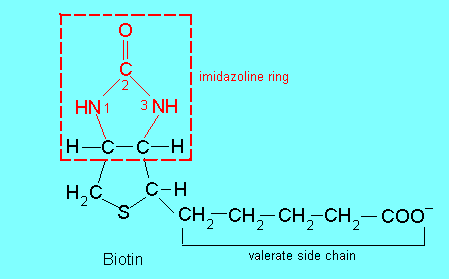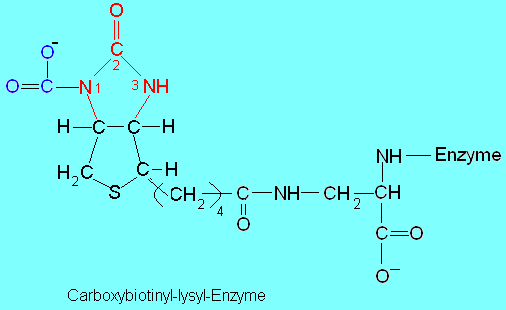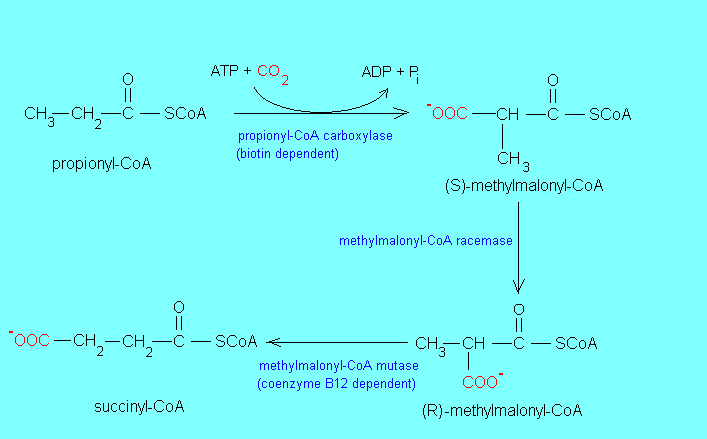|
Biotin
- Biotin functions as a prosthetic group in several carboxylases. It is covalently bound to the enzyme by an amide
linkage between the carboxyl group of the valerate side chain and the e-amino group
of the lysine residue of the polypeptide chain.


The prosthetic group functions as a CO2 carrier (as bicarbonate) by forming an intermediate carboxyl
substituent at its ureido group (N1 atom in the imidazole ring) followed by the attachment of the carboxyl group to
various compounds. Three of the four biotin-dependent carboxylases in humans are located in mitochondria (pyruvate-, methyl crotonyl-CoA -, propionyl-CoA carboxylase). The fourth, acetyl-CoA carboxylase is located in both mitochondria and cytosol.
An example of such a compound is the pyruvate (an a-keto acid) and the enzyme that catalyzes the reaction is the pyruvate carboxylase .
O
O
O
O
O
||
||
||
||
||
CH3-C-COO- + -O-C-OH + ATP ------>
-O-C-C-CH2-C-O- + ADP
oxaloacetate
Another reaction that requires the coenzyme biotin is the conversion of propionyl-CoA
to (S)-methylmalonyl-CoA (catalyzed by propionyl-CoA carboxylase ), the first step in the pathway from propionyl-CoA to succinyl-CoA, which is part of the degradation pathway for odd numbered fatty acids.

In the cell succinyl-CoA cannot be directly degraded by the citric acid cycle, which regenerates all its C4 intermediates, which act as catalysts rather than substrates. So, the net degradation of succinyl-CoA takes place via the citric acid cycle where succinyl-CoA is first converted to malate, which may subsequently be transported to the cytosol. There it is decarboxylated to pyruvate. From here on, the aerobic degradation of this C3 intermediate is well known to you and we need to elaborate no further.
Essential in the metabolism of carbohydrates, fatty acids and amino acids.
Biotin deficiency is rare because this vitamin occurs in many foods and is synthesized by intestinal bacteria. However, following excessive consumption of raw eggs biotin deficiency may occur because the egg white protein avidin prevents biotin absorption by forming a complex that does not cross the intestinal wall.
Interactions: Biotin works synergistically with the other B-group vitamins, coenzyme Q as well as carnitine (4-trimethylamine-3-hydroxybutyrate). Carnitine is involved in the transport of fatty acids into mitochondria where they are degraded. This transport is mediated by a specific carrier protein that carries the acyl-carnitine across the mitochondrial membrane. The same protein carries the free carnitine back to the cytosol. Antibiotics destroy the biotin-producing bacteria in the gut. Alcohol inhibits the absorption of biotin in the gut.
Health benefits: Biotin promotes strong nails and healthy hair and is useful in the management of seborrheic dermatitis and diabetes mellitus.
Best food sources: Cheese, organ meats and soybeans, cauliflower, eggs, mushrooms, whole wheat.
|



